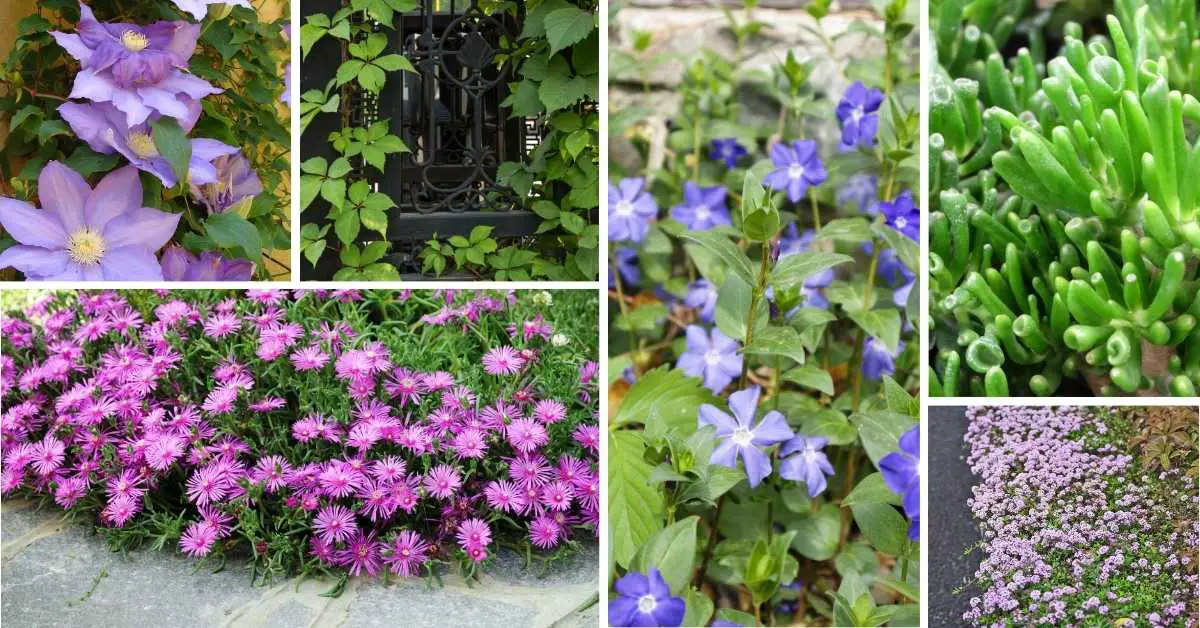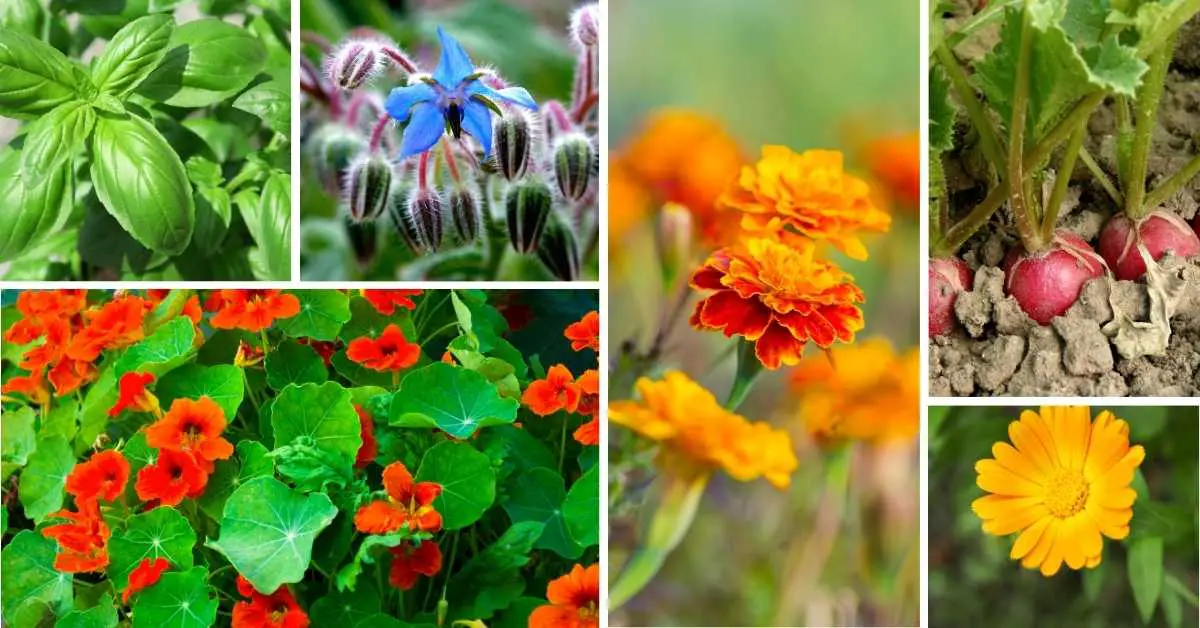If you’ve ever wanted to enjoy the fresh, vibrant taste of cilantro right from your own home, growing it indoors can be a rewarding experience.
From selecting the perfect container to understanding its sunlight requirements, there are specific steps you need to follow to guarantee successful growth.
But what happens when your cilantro starts to bolt, and how can you prevent it? Stay tuned to discover essential tips to keep your indoor cilantro thriving and flavorsome, even beyond the usual growing season.

Key Takeaways
- Choose a deep container with good drainage.
- Provide 6-8 hours of sunlight daily.
- Plant cilantro seeds evenly in well-draining soil.
- Water when the top inch of soil is dry.
- Use water-soluble fertilizer every 2-3 weeks.
Choosing the Right Container
When selecting the appropriate container for growing cilantro indoors, consider the size and material carefully to guarantee ideal growth conditions.
Container options for cilantro include pots, planters, or even repurposed containers with proper drainage holes to prevent waterlogging.
Adequate drainage is vital to prevent root rot, so make sure the container has sufficient holes at the bottom.
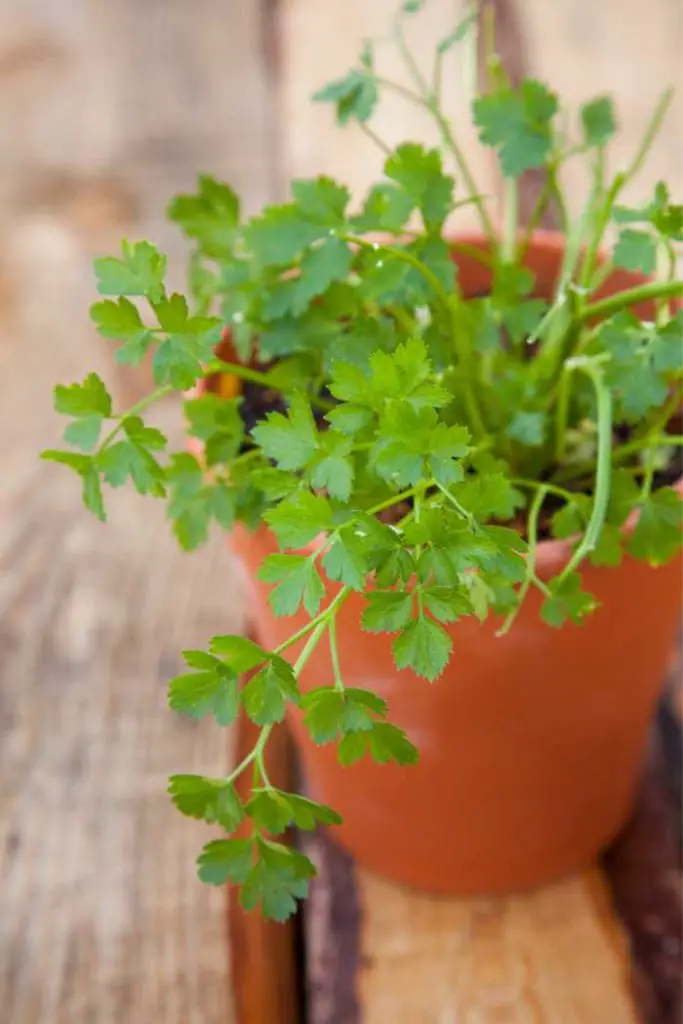
Size considerations are essential when choosing a container for cilantro. Opt for a container that’s at least 8-10 inches deep to accommodate cilantro’s long taproot system.
A width of around 12 inches allows ample space for multiple cilantro plants to grow without overcrowding. This size also helps maintain the moisture levels required for cilantro, as the larger volume of soil retains water better.
When it comes to watering requirements, make sure that the container allows excess water to drain effectively. Cilantro prefers moist soil but can suffer if waterlogged.
Check the moisture levels regularly and water when the top inch of soil feels dry to the touch. Remember, the right container size and drainage are key to fostering healthy cilantro growth indoors.
Selecting the Ideal Location
To guarantee successful growth of cilantro indoors, the next step is selecting the ideal location that provides the necessary light and temperature conditions for peak plant development. When choosing a spot for your cilantro, opt for a location that receives at least 6 hours of sunlight per day.
East or south-facing windows are ideal for providing the right amount of sunlight. Additionally, make sure the area is well-ventilated to prevent humidity build-up, which can lead to mold growth.
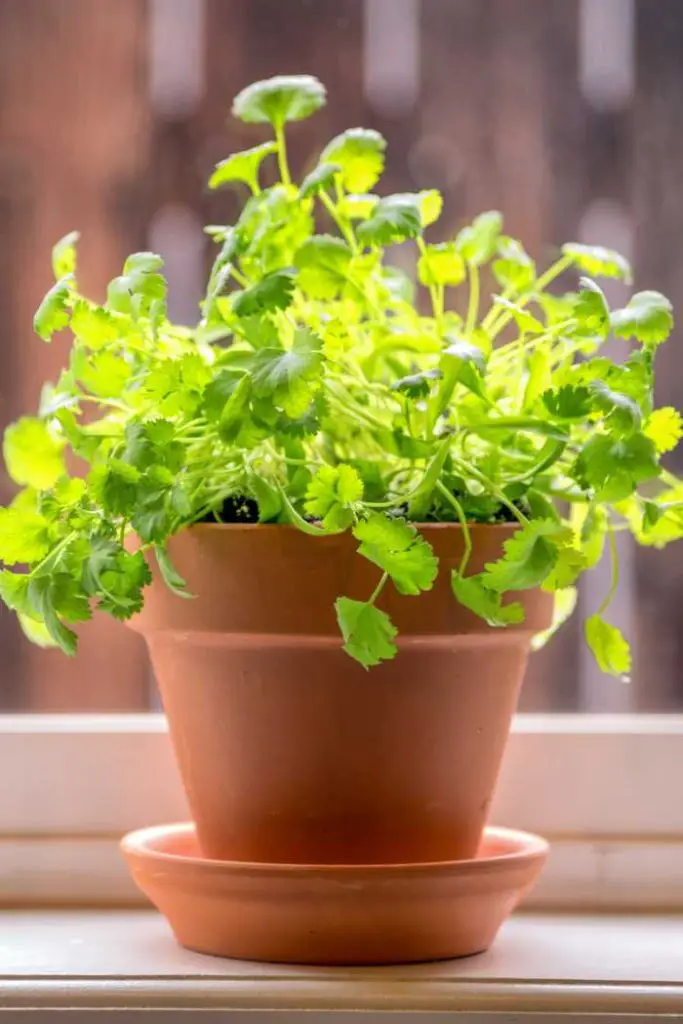
In terms of temperature, cilantro thrives in cooler environments between 60-75°F (15-24°C). Avoid placing your cilantro near heat sources like radiators or ovens, as excessive heat can cause the plant to bolt prematurely. Keep in mind that cilantro is sensitive to sudden temperature changes, so try to maintain a consistent environment.
Remember to take into account the container size when selecting the location. Make sure the pot is large enough to accommodate the roots and allow for proper drainage. Proper watering techniques are essential for cilantro’s growth, so choose a location that allows excess water to drain easily to prevent root rot. By selecting the right location, you set the foundation for healthy cilantro growth indoors.
Understanding Cilantro’s Sunlight Needs
Understanding the sunlight needs of cilantro is essential for successfully growing this herb indoors. Cilantro thrives in a location that receives plenty of natural light, ideally around 6-8 hours of sunlight per day. When choosing a spot, look for a south or west-facing window where your cilantro can bask in the sunlight.
If natural light is limited in your living space, don’t worry, as cilantro can also be grown under artificial lighting. Consider using fluorescent or LED grow lights placed about 6 inches above the plants for around 12-16 hours each day. This will mimic the sunlight exposure cilantro would receive outdoors.
Keep in mind that cilantro can be sensitive to intense heat, so if your indoor environment tends to get too warm, make sure there’s ample airflow to prevent the herb from wilting. By understanding and providing the right amount of light, you’ll set your indoor cilantro garden up for success.
Preparing the Potting Mix
You’ll want to start by selecting the right type of soil for your cilantro. Consider a well-draining potting mix with good aeration.
Mix in some organic matter like compost to provide essential nutrients for your plants.
Soil Selection
When preparing the potting mix for growing cilantro indoors, make sure you select a well-draining soil that’s rich in organic matter. This is essential for cilantro as it prefers slightly acidic to neutral pH levels around 6.0 to 7.0. Look for a potting mix that provides good moisture retention while allowing excess water to drain out to prevent root rot. A blend designed for herbs or vegetables works well.
You can also create your mix using equal parts peat moss, perlite, and compost. Remember, cilantro thrives in soil that isn’t compacted, ensuring the roots have enough oxygen. Choosing the right soil lays a strong foundation for healthy cilantro growth indoors.
Mixing Ingredients
For important cilantro growth indoors, make sure the potting mix is prepared by blending well-draining soil rich in organic matter with a slightly acidic to neutral pH level.
Ingredient combinations are essential for providing cilantro with the nutrients it needs to thrive. A recommended mix includes equal parts of potting soil, perlite, and compost. This blend ensures proper drainage, aeration, and nutrient retention, which are necessary for healthy cilantro growth.
The well-draining soil prevents waterlogging, while the organic matter enriches the soil with nutrients important for cilantro’s development. These ingredient combinations create an excellent environment for cilantro to flourish, enabling you to enjoy its fresh flavor in various culinary uses.
Prepare your potting mix thoughtfully to support your indoor cilantro garden’s success.
Planting Cilantro Seeds
To plant cilantro seeds successfully indoors, make sure you have a suitable container, quality potting mix, and a sunny location. Choose a container that’s at least 8 inches deep to allow the cilantro’s taproot to grow freely. Fill the container with a well-draining potting mix, leaving about an inch from the rim to make watering easier. Press the soil lightly to create a level surface for planting.
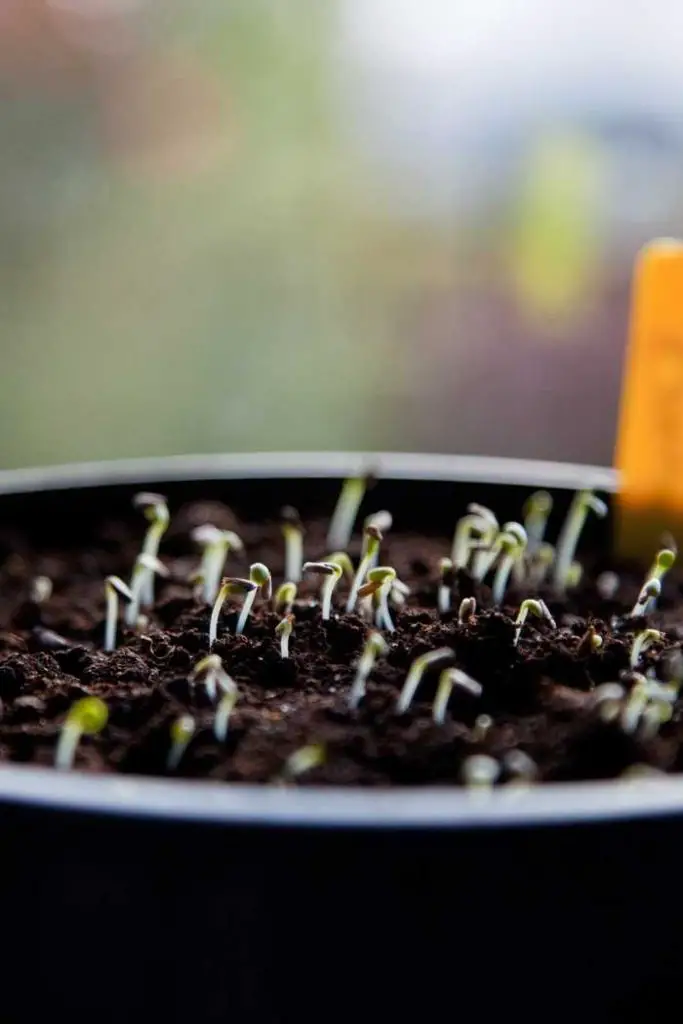
When planting the seeds, sprinkle them evenly over the soil, then cover them lightly with a thin layer of the potting mix. Water gently to avoid displacing the seeds. Place the container in a sunny spot, as cilantro loves sunlight. Consider companion planting with other herbs like basil or chives to enhance growth and repel pests.
As the seedlings grow, you may need to thin them out to ensure proper spacing for healthy development. Thinning seedlings involves removing the weaker ones, leaving around 3-4 inches of space between each plant. With proper care and attention, your cilantro seeds will soon sprout and flourish indoors.
Watering Cilantro Properly
To grow healthy cilantro indoors, it’s vital to water it properly. Maintaining the right soil moisture level and ensuring good drainage are essential for the plant’s well-being.
Overwatering can lead to root rot, while underwatering can cause the cilantro to wilt and dry out.
Proper Soil Moisture
Maintaining appropriate soil moisture levels is crucial for the successful growth of cilantro indoors. When it comes to watering frequency, cilantro plants prefer consistently moist soil. Water your cilantro when the top inch of the soil feels dry to the touch. This usually translates to watering every 2-3 days, but the frequency may vary based on your home’s temperature and humidity levels.
Overwatering can lead to root rot, while underwatering can cause the plants to wilt and affect the flavor of the leaves. By monitoring the moisture levels closely and adjusting your watering routine accordingly, you can guarantee that your indoor cilantro thrives and provides you with fresh, flavorful leaves for your culinary creations.

Drainage Is Essential
Proper drainage is important for maintaining the health and vitality of your indoor cilantro plants. To prevent issues like root rot, it’s essential to water your cilantro correctly. The frequency of watering depends on factors such as the size of the container and the potting mix used.
Choose a container with drainage holes to allow excess water to escape, preventing waterlogged soil. When watering, make sure that the soil is evenly moist but not waterlogged. A good rule of thumb is to water when the top inch of the soil feels dry.
Providing Adequate Drainage
For maximal growth of cilantro indoors, guarantee the pots have proper drainage to prevent waterlogging. Essential drainage is important to make sure the roots don’t sit in water, which can lead to root rot and hinder the plant’s growth. When selecting pots for your cilantro, opt for containers with drainage holes at the bottom. This allows excess water to escape, preventing the soil from becoming waterlogged.
In terms of watering frequency, having good drainage helps regulate the moisture levels in the soil, preventing overwatering. It’s important to water your cilantro plant when the top inch of the soil feels dry to the touch. The container size also plays a role in drainage – larger pots with proper drainage can help maintain a healthy root system by allowing excess water to escape more efficiently.
Fertilizing Your Cilantro Plant
To promote healthy growth, consider fertilizing your cilantro plant with a balanced, water-soluble fertilizer every two to three weeks during the growing season. Cilantro has moderate nutrient requirements, and organic fertilizers can be an excellent choice to provide essential nutrients. Look for fertilizers specifically formulated for herbs or vegetables, as they often contain the right balance of nutrients to support cilantro growth.
When it comes to the fertilizing schedule, consistency is key. By following a regular fertilizing routine, you can make sure that your cilantro plant receives the nutrients it needs for best growth. During the growing season, which typically spans from spring to fall, aim to fertilize your cilantro plant every two to three weeks. This consistent fertilizing schedule will help promote healthy foliage and robust flavor in your cilantro leaves.
Choose a water-soluble organic fertilizer and dilute it according to the manufacturer’s instructions. Over-fertilizing can lead to nutrient imbalances and potentially harm your cilantro plant, so it’s important to follow the recommended dosage. By providing your cilantro plant with the right nutrients at the right intervals, you can enjoy a bountiful harvest of fresh cilantro throughout the growing season.
Managing Temperature and Humidity
To successfully grow cilantro indoors, you must be mindful of maintaining the ideal temperature range and humidity levels. Keeping the temperature between 60-75°F and humidity around 50-70% will promote healthy growth.
Understanding the significance of the correlation between temperature and growth is essential for cultivating thriving cilantro plants in your indoor garden.
Ideal Temperature Range
Maintaining the ideal temperature range is essential when growing cilantro indoors to guarantee peak growth and health of the plant. For successful indoor cultivation, make sure the temperature remains between 60°F to 75°F (15°C to 24°C).
Cilantro thrives in moderate temperatures, so it’s vital to monitor and regulate the room where it’s growing. Fluctuations outside this range might stunt the growth or even harm the plant. Consider placing the cilantro pot in a spot that avoids drafts or sudden temperature changes. Using a thermometer near the plant can help you keep track of the temperature accurately.
Humidity Levels to Maintain
Ensuring the humidity levels in the environment where your indoor cilantro is growing are essential for its health and growth. To maintain ideal humidity levels, focus on humidity control and watering frequency.
Cilantro thrives in moderate to high humidity, ideally between 40% to 50%. To achieve this, consider using a humidity monitor in the growing area. Water your cilantro plant as needed, ensuring the soil is consistently moist but not waterlogged.
Adequate ventilation strategies, such as providing gentle air circulation with a fan, can also help regulate humidity levels. Avoid overwatering, as it can lead to excessive humidity around the plant.
Temperature and Growth Correlation
Maintain a harmonious balance between temperature and humidity levels to optimize the growth of your indoor cilantro. Temperature control is vital for cilantro to thrive indoors. Aim for temperatures around 65-75°F (18-24°C) during the day and slightly cooler at night.
Fluctuations in temperature can stress the plant, affecting its growth. Guarantee your cilantro receives adequate sunlight but avoid placing it in direct heat sources that can lead to temperature spikes. Growth optimization is closely tied to maintaining stable temperatures throughout the day and night.
Preventing Common Pests and Diseases
To keep your indoor cilantro plants healthy, be vigilant in identifying and addressing any signs of common pests and diseases. Pest management is essential in preventing infestations that can harm your cilantro. Keep an eye out for aphids, spider mites, and whiteflies, which can all be deterred by regularly inspecting the leaves and stems. If you notice any pests, try using natural remedies like neem oil or insecticidal soap to keep them at bay without harming your plants.
Disease prevention is equally important for the well-being of your cilantro. Make sure proper plant care by providing adequate air circulation and avoiding overwatering, as excessive moisture can lead to fungal diseases like powdery mildew. If you spot any signs of disease, promptly remove the affected leaves to prevent further spread.
Pruning and Thinning Cilantro
For ideal growth and flavor, regularly trim and thin out your indoor cilantro plants. Pruning tips are essential for keeping your cilantro healthy and productive. When pruning cilantro, focus on cutting the top leaves rather than the lower ones. This encourages the plant to grow more vigorously and prevents it from flowering too soon. Use clean, sharp scissors to snip off the leaves close to the stem without damaging it.
Thinning techniques are also important to make sure that your cilantro plants have enough space to grow and receive adequate airflow. To thin out your cilantro, simply pluck out some of the crowded seedlings, leaving behind the strongest ones. This prevents overcrowding, reduces competition for nutrients, and helps prevent diseases caused by poor air circulation.
Regularly practicing these pruning and thinning methods will help your indoor cilantro plants thrive. Remember, a little maintenance goes a long way in ensuring a bountiful harvest of fresh cilantro leaves for your culinary creations.
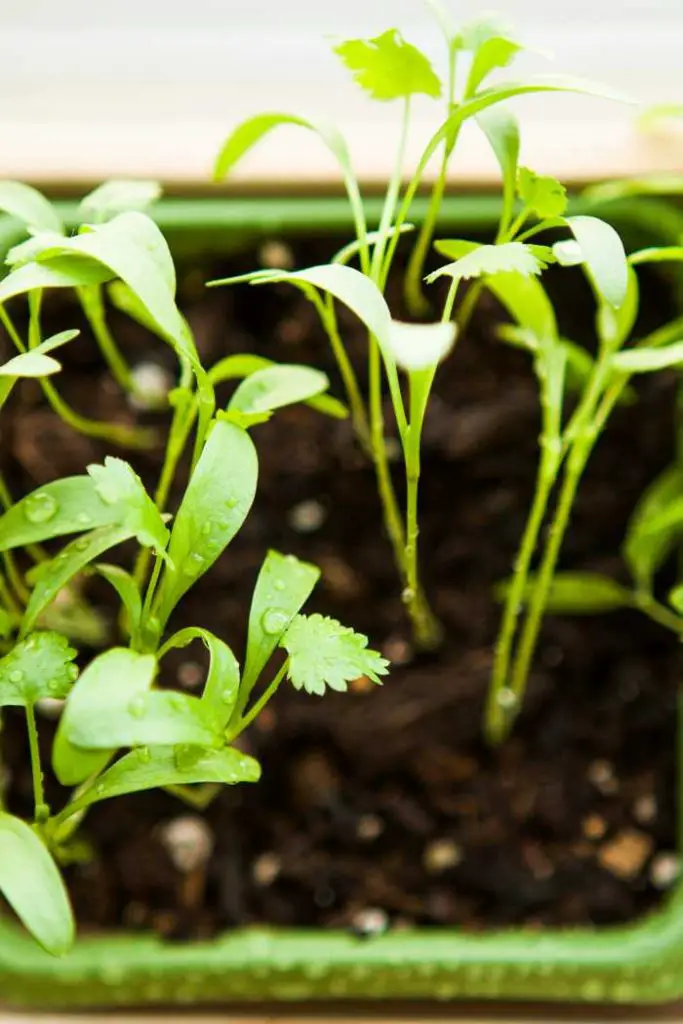
Harvesting Cilantro Leaves
When your indoor cilantro plants reach the ideal stage of growth, it’s time to start harvesting cilantro leaves for your culinary endeavors. To guarantee a continuous supply of fresh cilantro, pick the outer leaves first, allowing the inner leaves to keep growing. Use sharp scissors or pinch the stems gently to harvest the leaves. Cilantro is best harvested in the morning when the leaves are crisp and flavorful.
After harvesting, rinse the leaves under cold water and pat them dry with a paper towel. You can use the freshly harvested cilantro leaves immediately in your favorite recipes, such as salsas, guacamole, curries, or salads. Cilantro adds a burst of fresh flavor to dishes and is a staple in many cuisines worldwide.
To preserve excess cilantro, you can freeze the leaves in an airtight container or chop them up and mix them with olive oil in ice cube trays for convenient use later. Proper herb preservation guarantees you have cilantro on hand for all your culinary uses.
Extending the Cilantro Growing Season
Extend the cilantro growing season by implementing strategic techniques that optimize plant health and productivity. To achieve this, focus on maintaining the proper watering frequency. Cilantro plants prefer consistently moist soil, so check the top inch of soil regularly and water whenever it feels dry to the touch. However, make sure not to overwater as this can lead to root rot. Adjusting the watering schedule based on the plant’s needs is essential for promoting continuous growth.
Temperature control is another key factor in extending the cilantro growing season. Cilantro thrives in cooler temperatures around 60-70°F (15-21°C). To maintain these ideal conditions, consider placing the plant in a location with good air circulation and away from heat sources such as radiators or direct sunlight. Using a fan to circulate air can help regulate the temperature around the plant, ensuring it stays healthy and productive for longer periods.
Frequently Asked Questions
Can Cilantro Be Grown Hydroponically Indoors?
Yes, you can grow cilantro hydroponically indoors. Setting up a hydroponic system offers benefits like controlled nutrients and water usage. Indoor gardening techniques guarantee cilantro’s growth. With the right setup, you’ll have fresh cilantro at your fingertips.
How Long Does It Take for Cilantro Seeds to Sprout?
Cilantro seeds typically sprout in 7-10 days. Keep them moist but not waterlogged during germination. Once sprouted, place them in a sunny spot and water regularly. Protect seedlings from strong drafts.
Is It Safe to Use Tap Water for Watering Cilantro?
Using tap water for watering cilantro indoors is generally safe, but consider water quality for best growth. To guarantee sustainability, you can use filtered water or collect rainwater. Health concerns may arise from impurities, so alternatives like distilled water are recommended.
Can Cilantro Be Grown Alongside Other Herbs Indoors?
Sure, you can grow cilantro alongside other herbs indoors. Cilantro’s herb companions like parsley and chives make good neighbors. Consider their individual needs for light, water, and space when planning your indoor gardening techniques.
What Is the Best Way to Store Harvested Cilantro Leaves?
To store harvested cilantro leaves, you can air dry them by tying bunches and hanging them upside down. Another option is freezing the leaves in airtight bags. Refrigerator storage in a jar with water or dehydrating are also effective methods.
Conclusion
To sum up, growing cilantro indoors can be a rewarding experience with the right knowledge and care. By choosing the correct container, providing adequate sunlight, using well-draining soil, and maintaining proper watering and fertilizing practices, you can enjoy a bountiful supply of fresh cilantro right at your fingertips.
Remember to monitor for pests, prune regularly, and harvest leaves in the morning for the best flavor. With these tips, you can extend the growing season and enjoy your homegrown cilantro all year round.


